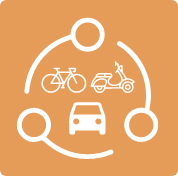
Smart mobility systems and services need to be evaluated in terms of their contribution to overall energy and transport system sustainability, rather than solely on their sectoral and often incremental impact along existing modes.
Similarly, efforts at deploying electric, shared and automated vehicle systems should be reviewed in terms of their strategic contribution to overall transport systems redesign rather than be predominately focused on electrifying, automating and expanding existing and unsustainable road-based individual motorisation modes.
The 2019 Strategic Transport Research and Innovation Agenda (STRIA) Roadmap for Smart mobility and services aims to identify transport research and innovation (e.g. multi-modal, electric and autonomous vehicles, drone technology and on-demand mobility services) that can contribute to the successful implementation of European Union (EU) decarbonisation goals.
It complements the 2017 STRIA roadmap on the same topic and recommends innovation actions that facilitate smart mobility systems and services.
PASSENGER TRANSPORT Innovation actions have focused on improving fuel efficiency, fuel substitution and electrification, automation of individual and freight transport, as well enabling mobility-on-demand. Although progress has been made in expanding active mobility mode shares in European cities, motorised individual road transport remains dominant and current strategies of electric, shared and automated individual car-based mobility are likely to exacerbate this trend.
The expansion and innovation of smart public transport services (both road and rail-based) in combination with micro-emobility, micro- transit and active mobility offer high potential for decarbonisation.
There are opportunities for significant modal shift away from car-based individual motorisation. The piloting of new ridepooling services and shared and autonomous shuttled or shared micro-mobility services offer promising potential, if operated in coordination with public transport.
URBAN AND REGIONAL FREIGHT The urban and regional freight sector has seen significant innovation through the deployment of real-time smart logistics information and track networks, warehouse automation, a growing fleet of electric delivery vehicles and the emergence of microdistribution (e.g. cargo bikes, drones).
However, urban freight demand continues to grow, driven by the demand for online retailing and delivery, as well as general economic growth.
WATERBORNE AND AIRBORNE Waterborne urban transport, as well as air and virtual mobility have been of a lesser or negligible focus, and future innovation actions should be directed at exploring and validating the potential contribution of air mobility (i.e. low altitude aerial and electric vertical take-off and landing) and virtual mobility systems and services in particular.
Urban and rural air mobility could provide for disruptive impact and could offer an alternative mode for electric urban freight and passenger transport, but a range of environmental, safety, technical and governance challenges will need to be validated and met to ensure it can be sustainably integrated with surface mobility modes and urban infrastructure.
Innovation actions should facilitate the pro-active integration of smart mobility services with existing public transport and utility systems to unlock their potential to significantly leverage low-carbon and efficient mobility in European cities and rural settings. This will require a renewed focus on their potential contribution to modal shift, behaviour change, energy transition and intelligent demand and land use management.
To this end, the roadmap recommends designing and prioritising innovation actions targeting five key areas:

- Smart mobility solutions sustainably interlinking urban and rural mobility systems.
- Develop urban design and land use strategies that promote active, micro and public mobility and that facilitate the integration of passenger and freight services.
- Defining new governance concepts, tools and technologies through large-scale systems implementation.
- Frame transport policy to foster inclusion, public acceptance and respect for diversity through research on behavioural change and user needs.

- Design and development of effective operating models that sustainably integrate public and individual mobility service provision.
- Development of integrated multimodal solutions providing a sustainable energy-transport nexus.

- Collecting and collating systemic and dynamic mobility data to contribute to effective policymaking and implementation.
- Fair-access digital infrastructure and mobility data management.

- Design and development of efficient solutions for integrated infrastructure and mobility systems shared by passenger and freight services.
- Expand and extend the role of active and light travel modes and use of micro-mobility solutions as part of integrated intermodal mobility systems.

- Test and validate the potential contribution of automated mobility services to sustainable, zero-carbon and integrated public transport systems.
- Test and validate real-world integration and governance of air mobility with urban and rural transport systems.
- Validate and integrate virtual mobility.
Data at-a-glance
TRIMIS Data at-a-glance presents the main transport research and innovation indicators based on TRIMIS data. Find out more about the geographical distribution of European Union transport research and innovation funding, discover the organisations involved in transport research activities and the evolution of funding. Discover the TRIMIS overview for overall data and the seven STRIA Roadmaps.
Further details are available in the full TRIMIS Dashboard.

